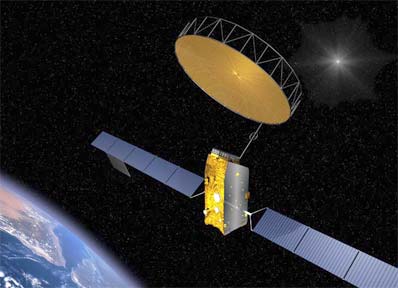
Spaceflight Now +

|

|

|

|

Premium video content for our Spaceflight Now Plus subscribers.

Station update
 A status report on the Expedition 11 crew's mission aboard the International Space Station is given during this news conference Monday. (55min 54sec file) A status report on the Expedition 11 crew's mission aboard the International Space Station is given during this news conference Monday. (55min 54sec file)

 Play video: Play video:
Dial-up | Broadband

Shuttle collection
 As excitement builds for the first space shuttle launch in over two years, this comprehensive video selection captures the major pre-flight events for Discovery and her seven astronauts. As excitement builds for the first space shuttle launch in over two years, this comprehensive video selection captures the major pre-flight events for Discovery and her seven astronauts.
 See selection See selection

Tropical Storm Arlene
 A camera on the International Space Station captured this view of Tropical Storm Arlene moving into the Gulf of Mexico as the orbiting complex flew above the weather system at 2:33 p.m. EDT on Friday, June 10. (3min 06sec file) A camera on the International Space Station captured this view of Tropical Storm Arlene moving into the Gulf of Mexico as the orbiting complex flew above the weather system at 2:33 p.m. EDT on Friday, June 10. (3min 06sec file)
 Play video Play video

Hurricane research
 NASA's space-based research into how hurricanes form and move is explained in this narrated movie from the agency. (8min 02sec file) NASA's space-based research into how hurricanes form and move is explained in this narrated movie from the agency. (8min 02sec file)
 Play video Play video

Volcano on Titan?
 Dr. Bonnie Buratti, team member of the Cassini visual and infrared mapping spectrometer, discusses a possible volcano discovered on Saturn's moon Titan. (2min 12sec file) Dr. Bonnie Buratti, team member of the Cassini visual and infrared mapping spectrometer, discusses a possible volcano discovered on Saturn's moon Titan. (2min 12sec file)
 Play video Play video

Shuttle oversight
 The co-chairs and other members of the Stafford-Covey Return to Flight Task Group, which is overseeing NASA's space shuttle program, hold a news conference in Houston on June 8. The co-chairs and other members of the Stafford-Covey Return to Flight Task Group, which is overseeing NASA's space shuttle program, hold a news conference in Houston on June 8.

 Play video: Play video:
Presentation | Questions

 Become a subscriber Become a subscriber
 More video More video

|

|

|

|
|

|

Atlas 5 picked by Inmarsat for launch agreement
ILS NEWS RELEASE
Posted: June 13, 2005
Less than three months after the successful launch of the first of its next-generation satellites, Inmarsat has returned to International Launch Services (ILS) to add the Atlas V vehicle as an option for future I-4 launches.
| |

The Lockheed Martin Atlas 5 rocket ascends from Complex 41. Photo: ILS
|
An ILS Atlas V launched the first Inmarsat-4 satellite on March 11
from Cape Canaveral, Fla. The satellite, one of the largest and most
sophisticated commercial satellites ever launched and 60 times more
powerful than its predecessors, began operations last week. The Atlas
V is built by Lockheed Martin, which is a partner in the
ILS joint venture.
"We're pleased to have helped Inmarsat lay the foundation for its
new broadband service by launching the first I-4 satellite this year,"
said ILS President Mark Albrecht. "We thank Inmarsat for again putting
its confidence in ILS and Atlas V."
"The new contract for Atlas V provides flexibility to serve as a
backup for the launch of the Inmarsat-4 F2 spacecraft, now nearing
completion at EADS Astrium in Toulouse," said Gene Jilg, Inmarsat vice
president responsible for the Inmarsat-4 program. "Backup capability
using a different vehicle family from the prime has been a hallmark of
Inmarsat's strategy for three satellite generations. Atlas has
delivered 100 percent reliability for Inmarsat thus far and we look
forward to continued success."

An artist's concept shows the Inmarsat 4-series satellite in orbit. Credit: EADS Astrium
|
The I-4 constellation will support the introduction of the new
BGAN service, delivering internet and intranet access,
video-on-demand, videoconferencing, fax, email, phone and LAN access
at speeds of up to half a megabit per second. BGAN will also be
compatible with 3G cellular systems. The I-4 satellites are Eurostar
E3000 models built by EADS Astrium, weighing nearly 6 metric tons.
ILS is a joint venture of Lockheed Martin of Bethesda, Md., and
Khrunichev State Research and Production Space Center of Moscow. ILS
is the global leader in launch services, offering the industry's two
best launch systems: Atlas and Proton. With a remarkable launch rate
of 74 missions since 2000, the Atlas and Proton launch vehicles have
consistently demonstrated the reliability and flexibility that have
made them preferred choice among satellite operators worldwide. ILS is
headquartered in McLean, Va., a suburb of Washington, D.C.
|

|

|

|

|



